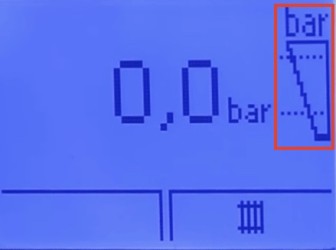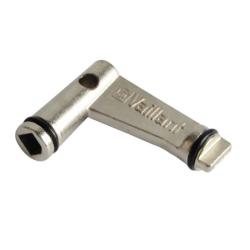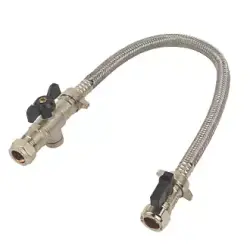What is boiler pressure?
Boiler pressure is the pressure of hot water circulating through your central heating system.
Your Vaillant boiler has an optimal pressure level that must be maintained in order for the boiler to heat up your home and hot water effectively.
If the boiler pressure gets too high, there is a chance of leaks developing in your central heating system. If the pressure drops too low, your home and hot water will take longer to heat up, and your boiler will have to work harder to supply the central heating system with water, resulting in higher energy bills.
How do I check my Vaillant boiler pressure?
All Vaillant combination and system boilers have an analogue or digital pressure gauge on the front that displays the current level of pressure in the system.
What should my Vaillant boiler pressure be?
When the heating is off
When your heating is off, your Vaillant boiler pressure should be between 1 and 1.5 bar. If the boiler pressure drops below 1 bar, your boiler may not work properly, and it will display an error code informing you to top up the pressure as soon as possible.
When the heating is on
When your heating is on, your Vaillant boiler pressure should be between 1 and 2 bar, and should not exceed the upper limit of 3 bar. When the water in the heating system heats up, it expands, resulting in an increase in boiler pressure. If your boiler pressure does go above 3 bar, your Vaillant boiler is fitted with safety mechanisms to deal with the increase.
How will I know if my Vaillant boiler pressure is too low?

- Your radiators aren’t heating up properly.
- You have no hot water or heating.
- The analogue pressure gauge has dropped below 1 bar.
- The pressure gauge is below the lower dotted line on the digital display (see image).
- Your boiler is displaying an F22, F24, F73, or F75 fault code.
How will I know if my Vaillant boiler pressure is too high?
- Your boiler is making a humming or rattling sound.
- The analogue pressure gauge is above 3 bar.
- The pressure gauge is above the higher dotted line on the digital display.
Why is my Vaillant boiler pressure low?
Low boiler pressure is a common problem with most boiler systems. If your boiler pressure is low, then there is not enough water in the system. There could be a number of reasons why your Vaillant boiler pressure has dropped. Here are a few of the most common causes:
Your boiler has been off for a long time
If you haven’t turned on your heating for a while, like during the summer or if you have been away from home for a long time, the amount of water circulating in the system will have dropped, resulting in your boiler losing pressure.
If you haven’t used your boiler for a long time and its pressure is low, turning on the central heating could fix the issue. Turning on your central heating will get some hot water circulating through the system, and your Vaillant boiler pressure should rise back within its optimal range.
You have recently bled your radiators
If you have recently bled your radiators, you may have let out too much trapped air from the system. If this is the case, your boiler’s pressure will have dropped. The released air will need to be replaced with water in order to get the pressure back up. You can find out how to do this further down in this guide.
Your boiler or central heating has a leak
A leak in your central heating system will reduce the amount of water flowing through it and result in a loss of pressure.
Locating a leak can be tricky, as it could be anywhere along your central heating system. The first place you should check for leaks is around your radiators. If you find puddles of water or other signs of moisture around the pipework around your radiators, then you may have a leak. There may not always be signs of water around a leak, as the water might have dried before you notice it, but you may be able to see signs of water damage such as discolouration on wooden flooring, swollen skirting boards, water stains on ceilings, or rust marks around your radiators.
There could also be a leak within the boiler itself. If your boiler has not been regularly serviced and maintained properly, some parts may loosen or corrode over time, and cause your boiler to lose pressure. A leak in your boiler will be easier to spot as you will usually be able to see water dripping from underneath the boiler.
If you do have a leak in your central heating system or boiler, you will need to call a Gas Safe Registered engineer to fix it.
Give your boiler a service.
Make sure you don't invalidate your warranty. Call Smart Plan to get a boiler checkup to see if everything is in good working order.
Faulty boiler parts
Faulty boiler parts such as the pressure relief valve, pump, or expansion vessel could be the reason why your boiler pressure has dropped. If a faulty boiler part is causing the pressure to drop, it will be difficult for you to identify the fault. You will need to call a Gas Safe Registered engineer to identify and fix the problem.
Let us fix your boiler.
At Smart Plan we have thousands of engineers up and down the country who are ready to fix your issue. We guarantee an engineer to your property within 48 hours.
How can I increase my Vaillant boiler pressure?
You will be able to increase your Vaillant boiler pressure by using its filling loop. The filling loop is a device that connects the central heating system to the mains water supply and is used to fill the heating system with water when it needs repressurising.
Please note
If your boiler has lost pressure as a result of a fault, increasing its pressure may only be a temporary fix. If you top up your boiler pressure and it keeps on losing pressure, then it is time to call a professional to get to the root cause of your pressure issues.
Filling key

Some Vaillant boiler models, mainly combi boilers, use a filling key to repressurise the system. The filling key can usually be found on the concealed tray underneath the boiler, or it may have been provided to you separately with the boiler manual.
To increase your Vaillant boiler pressure using its filling key, follow these steps:
- Turn off the boiler.
- Insert the filling key into the keyhole and unlock it.
- Using a screwdriver or wrench, turn the valve next to the filling key. Once unlocked, you should be able to hear water flowing into the system.
- Keep an eye on the boiler pressure gauge. Once it reaches around 1.5 bar, close the valve and remove the filling key.
- Your boiler should now be repressurised. You can turn it back on. After it runs its start up sequence, it will be ready for use.
Flexible braided hose filling loop

Some Vaillant boiler models, mainly system boilers, use a flexible braided hose filling loop to increase the system pressure. The filling loop will be located below or around the boiler or close to where your hot water cylinder is installed.
To increase your Vaillant boiler pressure using its braided hose filling loop, follow these steps:
- Turn off the boiler and allow the heating system to cool down.
- Locate the filling loop. The filling loop will have two valves. The valves may be opened by either turning handles, being opened with a screwdriver, or a combination of both.
- Open the first valve by turning it 90 degrees anticlockwise. The isolation valves are open when the valve head is in line with the pipe.
- While keeping an eye on the pressure gauge, slowly open the second valve. You should now hear water entering the boiler to repressurise it.
- Once the pressure gauge reaches between 1 and 1.5 bar, close the second valve.
- Close the first valve.
- Ensure both valves are completely closed.
- Your boiler should now be repressurised. You can turn it back on. After it runs its start up sequence, it will be ready for use.
What should I do if my Vaillant boiler pressure is still too low?
If you have repressurised your boiler and it continues to drop, there is a high possibility that there is a leak somewhere along the central heating system, if not, then there may be a problem with some of the boiler’s components. If this is the case, do not keep trying to increase the boiler pressure, as you may cause further damage. Instead, call a qualified boiler engineer.
Let us fix your boiler.
At Smart Plan we have thousands of engineers up and down the country who are ready to fix your issue. We guarantee an engineer to your property within 48 hours.
Why is my Vaillant boiler pressure high?
The water pressure has been topped up too much
If your boiler pressure was low and you topped it up, you might have topped it up with too much water. When boilers are in use, the water in the system expands and the pressure increases. If you increase your boiler pressure higher than recommended, the added pressure once the water expands, could push it above the optimal level.
The filling loop is open
As you know, the filling loop is used to bring more water into your central heating system. If the filling loop is still open or if it is faulty, water will continue to enter the system, which will result in an increase in boiler pressure. If you have a braided hose filling loop, make sure that both valves are closed. If you have a keyed filling loop, make sure that the key is not still in the keyhole in an unlocked position, if it is, lock it and remove the key.
Faulty pressure relief valve
Your boiler’s pressure relief valve prevents a buildup of pressure in the system. Over time, a pressure relief valve can wear out and stop working. If this is the case, then it will not be able to do its job efficiently and will not release water when the pressure gets too high.
Faulty expansion vessel
If you have a Vaillant combination boiler, it will have an expansion vessel. The purpose of the expansion vessel is to keep the pressure in a combi boiler stable while the water in the system heats and cools. If the expansion vessel is damaged or faulty, it may not be able to maintain the optimal level of pressure in the boiler system, which could result in an increase in pressure.
How can I decrease my Vaillant boiler pressure?
Bleed a radiator

The most common way to reduce boiler pressure is to bleed a radiator. Bleeding a radiator removes excess water and air from the boiler system and can easily be done with a radiator key. A radiator key is a small, butterfly-shaped key (see image). If you don’t have one, you can buy one online or from your local DIY shop for a few pounds. Alternatively, you can use a flat-head screwdriver.
How to reduce boiler pressure by bleeding a radiator:
- Make sure your central heating system is turned off.
- Place a jug underneath the radiator bleed valve to catch the water that will be released once you start bleeding the radiator.
- Insert the radiator key, or flat-head screwdriver, into the radiator bleed valve and turn it slowly in an anti-clockwise direction.
- Allow some water and air to be released from the radiator.
- Check the pressure gauge on your boiler. Once the pressure gauge is between 1 and 1.5 bar, close the valve.
- You can now turn your central heating system back on.
What should I do if my Vaillant boiler pressure is still too high?
If you have taken steps to reduce boiler pressure but it is still too high, there may be an issue with the pressure relief valve, the filling loop, the expansion vessel, or another issue that can only be identified and repaired by a Gas Safe Registered engineer.


